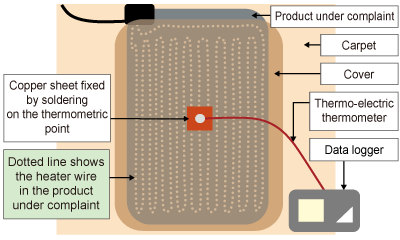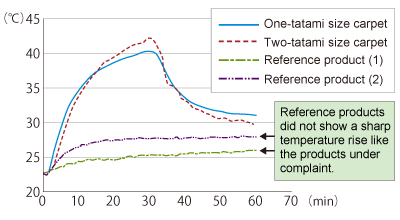Electrically heated carpets that automatically operate in the "high" mode for the first 30 minutes
There has been a complaint that electrically heated carpets got too hot to sit on. NCAC examined the products and found that the carpets were designed to automatically operate in the high mode for the first 30 minutes and the surface temperature rose to 40-42 degrees centigrade. The operational method was not clearly indicated by product labels.
Details of the inquiry
I bought two electrically heated carpets: one was in one-tatami size and the other was in two-tatami size. The one-tatami size carpet got too hot to sit on. Even after switching to the "low" mode, the set temperature range of which was the lowest, it remained too hot to sit on. The two-tatami size carpet, which was equipped with a temperature sensor, got too hot even in the "low" mode and it automatically turned off. When I made a complaint to the store, they told that they would replace the products with new ones if I brought them to the store. However, I thought it would be dangerous if the same phenomenon occurred when using a new one. I want to return the products rather than replacing with new ones. I would like to request you to check the surface temperature of the electrically heated carpets during operation.
Product test and investigation
After receiving the inquiry, the local consumer affairs center requested NCAC to conduct relevant product tests. The test results showed the following.
(1)Products under complaint
The products under complaint were electronically heated carpets, which were laid on the floor to directly warm users.
The inquirer provided the one-tatami size and two-tatami size carpets together with exclusive covers which had been used with the carpets. The products were not in stock and it was unable to buy new one.
Both of the two carpets were labeled PSE mark, which shows compliance with the technical standards under the Electrical Appliances and Materials Safety Act.
In addition, each of them was accompanied with an instruction manual, which said "the product automatically operates in the high mode for the first 30 minutes". However, the manual did not mention that it was possible to release the automatic operation.
Specification of the products
- One-tatami size
- Rating: AC100V, 50/60Hz, 200W
Approximate dimension: 176 x 88 cm
Temperature control mode: from low to high
Power consumption & surface temperature:
Middle mode: about 110Wh, around 35 degrees centigrade
High mode: about 141Wh, around 45 degrees centigrade
Others: PSE mark affixed - Two-tatami size
- Rating: AC100V, 50/60Hz, 500W
Approximate dimension: 176 x 176cm
Temperature control mode: from low to high
Power consumption & surface temperature:
Middle mode: about 220Wh, around 35 degrees centigrade
High mode: about 298Wh, around 45 degrees centigrade
Others: PSE mark affixed
(2)Appearance check of the products under complaint
Both of the two products showed no abnormality. No dirt or damage noted.
(3)Operational check and measurement of surface temperatures
In the same way as the inquirer used the products, each electrically heated carpet was laid on the floor and covered with the exclusive cover. Then the switch was turned on to check operation.
The temperature controllers of the two carpets allow users to set the temperature mode to "low", "middle" or "high". Therefore, NCAC measured their surface temperatures in the individual modes of "low", "middle" and "high". (See Diagram 1)
Diagram 1: How the surface temperature was measured (visualization)
- The test was conducted referring to the clause "Test for tolerance on set temperature" of JIS C 9216 "Electrically heated area rugs". A square flat copper sheet with one side of 65 mm and a thickness of 0.5 mm to which a heat sensor of thermo-electric thermometer is fixed by soldering or the like was placed on the thermometric point. A piece of foamed styrol was placed on the copper sheet, and a weight of 3 kg was placed on the foamed styrol piece. The temperature was measured at the center of each of the products under complaint for 60 minutes at room temperature around 20 degrees centigrade.
Regardless of the temperature control mode, the surface temperature of the two products rose to 40-42 degrees centigrade in the first 30 minutes, and then dropped after 30 minutes and stabilized within the set temperature range of individual modes of "low", "middle" or "high".
In addition, NCAC purchased two brands of one-tatami size electronically heated carpets manufactured by different companies and activated under the same conditions as above for comparison. The surface temperature of those reference products did not reach 40-42 degrees centigrade during the first 30 minutes, and stabilized within the individual temperature ranges of modes "low", "middle" and "high". (See Diagram 2)
Diagram 2: Surface temperature change during operation (in the "low" mode)
The surface temperature of the products under complaint rose to 40-42 degrees centigrade during the first 30 minutes, while that of the reference products did not rise so sharply and stabilized within the set temperature range of the "low" mode.
NCAC further checked if the surface temperature distribution would differ when the exclusive cover on the electrically heated carpet is replaced with another one. NCAC purchased another cover and tested with it. The surface temperature distribution when operating one hour at room temperature around 20 degrees centigrade with another cover did not differ so much from the surface temperature distribution when using the inquirer's cover under the same conditions.
According to the test results, the most probable reason that the inquirer felt too hot to sit on it even when setting to the "low" mode was that the surface temperature rose to 40-42 degrees centigrade during the first 30 minutes, regardless of the mode.
Summarized outcome
The local consumer affairs center informed the sales company of the test results.
The sales company replied that the manufacturer had already discontinued the electrically heated carpets, which had been designed to automatically operate in the high mode for the first 30 minutes. They told that they would seek to make easy-to-understand product labels when they sell electrically heated carpets with similar function. The sales company gave a refund to the inquirer.
